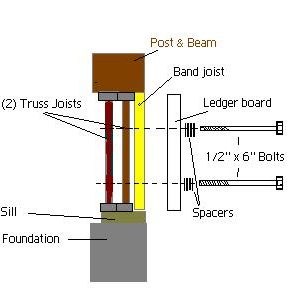I’m building a covered porch across the front of my house. I’ll be using a 2×10 pressure treated ledger board to tie the deck portion into my house. I have a “Truss Joist” band on the other side of my 2×10 band joist. Some of it is solid blocking. My questing is this, how do I fasten the ledger board to the house? If I tighten the bolts the web area of the “TJ’s” are comprimised. I included a simple diagram so it is clearer (hopefully).



















Replies
Run your bolts through blocks that span the gap between the top and bottoms chords of the tji's. Or simply use more bolts so that there is less force on the web. The purpose of the bolts is to counteract horizontal motion of the deck. If you use plenty of nails to support the vertical load of the deck, there is not much force on the bolts.
I'd either replace the existing rim joist with LVL material or solid block both sides of the webbing flush with the flange of the I-joist at all bolt locations.
Wait... maybe I'm not reading you right. Is the ledger for your deck running perpendicular or parallel with the I-joists?
Sorry been a long day with the concrete pour. I included a pic of the view looking down. I like your idea of blocking the web and putting the applied force on the flanges.I planned on running fasteners between every joist.After last years accident in Chicago(many people died in a porch from house separation), our building inspector is being a pain in the arse. I appreciate the replies.
Anyone have experience with the Ipe deck fasteners(Eb-Ty)? Ease of use?
Putting them in with a router? appearrance? I'm putting a full front porch on the house (40') with an 8' depth. Putting 5/4 x 6 Ipe down on 16" OC. Price of fasteners sure adds to the price of a porch.
I would definitely not use Eb-Ty fasteners with ipe. There have been many discussions of this.
Why not set posts next to the foundation wall. You coud even quick bolt it to the wall (concrete I assume), and build the deck as an independent structure. No load at all is placed on the rim joist or truss joist and your BI should be happy.
Dave
Backing up the I-Joists with Web-to-Web dimensional lumber has been mentioned a few times and you've seemed to pick up on that. That would be my solution, too.
Pre-cut some 2x4 or 2x6 material to a length equal to the height of the I-Joist. Go Outside and tack up your ledger (without the spacers). Drill your carriage bolt holes through the ledger, rim, and double I-joists. Go back inside and find the holes and cover them with your pre-cuts (Nail to top and bottom flanges). Go back outside and drill through the old hole and through the new pre-cuts. Push through a couple of extra long carriage bolts on either end of each ledger board. Spin some nuts on those inside. Now you can pull your nails holding up the ledger, pull it put from the house a bit, and insert the bolts through the ledgers-spacers-rim-double I's-2x's you get the idea. . Less in-out-in-out if you have a helper.
http://jhausch.blogspot.comAdventures in Home BuildingAn online journal covering the preparation and construction of our new home.
View ImageSamT
I'm curious - Why the I-joist blocking? I've never seen a situation where it was required like that.How about drilling a 2 or 3" hole in the webs of the I-joist blocking to allow access to the rim board? If the I-joist blocking isn't really needed I don't know why it wouldn't work.
To be sure of hitting the target, shoot first and call whatever you hit the target. [Ashleigh Brilliant]
THanks all. Funny what a good night sleep and good suggestions will do.
The Trus Joist blocking was put around the perimeter because of the post and beam style construction. All the force is on the perimeter. Where ever the 6"x10" posts meets the deck, there is blocking underneath the post.
Since you seem to have access to the back side of the TJs, why not put a block of 2x there spanning from bottom flange to top flange and bolt through that - no force on the web that way and plenty of strength to hold your bolts.
BruceT
If your rim joist is 2x material then just add web stiffeners in the outermost TJI and then lag through rim joist and into the stiffened joist. If you can access it, it's even better if you can fill the cavity between the two TJIs and lag right through.
Thanks for the drawings--makes it a lot clearer. Basically, you are worried about pulling on the web of the innermost "I", and you cannot get between the two "I's" with blocking, right? My thoughts are to either drill oversized holes in the centers (up/down) of the webs and put a second ledger on the inside (nailed to the flanges of the innermost I-joist with blocking at the bolt locations (or even a continuous board) between it and the web. That way forces will be distributed all along the whole "I" and shouldn't pull too hard on the web. Second idea would be to do as another poster suggested and put another set of posts up near the house and cantilever to the house, but leave a space for drainage and don't use a ledger at all--don't fasten to the house.
As far as blocking or bridging between the other I-joists, why not nail a long 2x4 perpendicular to them on their bottom flanges every six or eight feet?
You could solve the problem by avoiding it. Bolt a double ledger to the foundation wall and set the deck joists on top.
I was talking about your question at breakfast this morning and thought--wouldn't there already be squash blocks between the webs of the I-joists at the perimeter walls anyway? Aren't they required where there is a load above--even where interior walls land above an I-joist, it is supposed to have squash blocks. So if you drill through where those are, problem is solved.